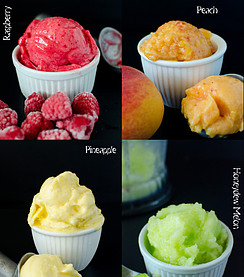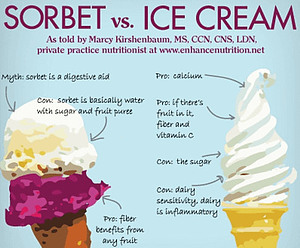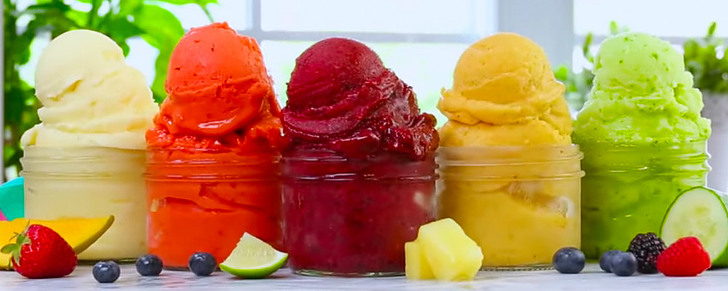Learn all about the refreshing dessert that is Sorbet – a ‘lighter’ alternative to ice cream. A Guilt-free, healthful, fruity sweet and refreshing frozen treat.
Sorbet, when you think of sorbet, you think of fresh fruit, bold flavours and colours, and super healthy. Sorbet is known for its light and smooth texture, bursting with natural fruit flavours that offer a refreshing and cooling sensation on a hot summer day.
Sorbet is also a very popular choice among those seeking dairy-free and vegan-friendly options for a sweet and tangy treat.
 Whether enjoyed as a palate cleanser between courses or savoured as a guilt-free indulgence, sorbet is sure to bring a smile to your face with its vibrant colours and array of delicious tastes and as sorbets tend to not incorporate dairy products, Sorbet is a much lighter alternative to ice cream.
Whether enjoyed as a palate cleanser between courses or savoured as a guilt-free indulgence, sorbet is sure to bring a smile to your face with its vibrant colours and array of delicious tastes and as sorbets tend to not incorporate dairy products, Sorbet is a much lighter alternative to ice cream.
In this article, we’ll take a look at Sorbet’s origins and various flavour options, we’ll discuss the healthy benefits of Sorbet, detail the differences between Sorbet vs Ice Cream and we’ll provide a simple method for creating sorbets.
Origins of Sorbet
The term “sorbet” was used to describe a beverage in the 16th and 17th centuries, and it was still being used for drinks in the 19th century. The word “sorbet” is believed to have been adopted for the first time in the Middle Ages because the word resonated the sound of those who tasted sorbet, whilst sucking a little at the sharpness of sorbet.
The word “sorbet” is derived from the Italian word “sorbetto”. The Italian term, in turn, came from the Ottoman Turkish or Iranian word “sharbat,” which originally referred to a type of beverage.
The Arabic verb “shariba,” meaning “to drink,” is the root of the word “sharbat”. There’s also the Arabic word “sherbeth,” which means fresh drink.
The word “sorbet” is also related to the Latin verb “sorbeo-es-sorbui,” which means to suck or to sip.
Sorbets are believed to have originated in ancient Persia as far back as 550-530 BCE.
Different Flavours of Sorbet
Sorbet comes in a wide variety of flavours, offering something for everyone’s taste preferences. Some popular flavours of sorbet include:
- Strawberry: Made from fresh strawberries, this flavour is a classic and always a crowd-pleaser.

- Mango: The tropical sweetness of mango makes for a delicious and refreshing sorbet.
- Raspberry: The tartness of raspberries adds a tangy twist to the sorbet.
- Lemon: Lemon sorbet is known for its bright and zesty flavour, perfect for a hot summer day.
- Honeydew Melon: Honeydew Melon sorbet is a refreshing and hydrating option, ideal for beating the heat.
- Passion Fruit: The exotic and tangy flavour of passion fruit adds a unique twist to sorbet.
- Coconut: Coconut sorbet offers a creamy and tropical taste that is loved by many.
- Pineapple: The tropical sweetness of pineapple makes for a delicious summer sorbet flavour.
These are just a few examples, and the possibilities for sorbet flavours are endless. Almost any fruit can be used to create sorbet, allowing for a huge range of flavour combinations.
Methods of Making Sorbet
Making sorbet is a relatively simple process that can easily be done at home.
The basic steps for making easy homemade sorbet are as follows:
- Prepare your chosen fruit: Start by selecting ripe and flavourful fruit.
- Wash and peel the fruit as needed, removing any seeds, stones or pips.
- Blend or puree the fruit: Use a blender or food processor to puree the fruit until smooth.
- Strain the puree if desired to remove any solids.
- Sweeten the puree: Add sugar or a sweetener of your choice to the fruit puree. The amount of sweetener needed will depend on the sweetness of the fruit and personal preference.
- Add flavourings (optional): You can enhance the flavour of the sorbet by adding additional ingredients such as citrus zest, herbs, or spices, again this is entirely down to personal preferences.
- Chill the mixture: Place the fruit puree in the refrigerator to chill for at least a few hours or overnight, this step allows the flavours to combine and enable the mixture to cool before freezing.
- Freeze the mixture/Churn the mixture: Pour the chilled fruit puree into an ice cream maker and follow the manufacturer’s instructions for freezing/churning.
- (NB: If you don’t have an ice cream maker, you can pour the mixture into a shallow dish and place it in the freezer. Stir the mixture every 30 minutes, to avoid crystals forming until it reaches the desired consistency). Head on over to our article – How to Make Homemade Ice Cream Without an Ice Cream Maker – for more detailed information on this.
- Serve and enjoy: Once the sorbet has reached the desired consistency, it is ready to be served. Scoop it into bowls or cones and enjoy the refreshing and fruity flavours.
What are the Differences Between Sorbet and Ice Cream
Sorbet and ice cream are both frozen desserts, obviously, but they differ in several ways. Here are the main differences between sorbet and ice cream:
Sorbet:
- Made from fruit or fruit juice and sweetener.
- Does not contain any dairy products.

- Has a more acidic taste, resulting in tart flavours.
- Typically has a lower fat content than ice cream.
- Can be a good alternative for those with non-dairy dietary needs or lifestyle preferences.
Ice Cream:
- Made from milk, cream, sweetener, and sometimes eggs.
- Contains dairy products.
- Has a creamy and smooth texture.
- Typically has a higher fat content than sorbet.
- Comes in a wide variety of flavours, including some that contain mix-ins like chocolate chips or nuts.
Overall, the main difference between sorbet and ice cream is the presence of dairy products. Sorbet is a good option for those who are lactose intolerant or have other dietary restrictions, while ice cream is a classic dessert that is loved globally for its heavier, creamy texture.
How does the texture of sorbet compare to ice cream
Sorbet and ice cream have different textures due to their ingredients and preparation methods. Here are some ways in which the texture of sorbet compares to ice cream:
Sorbet:
- Heavily blended to give a smooth texture.
- The absence of cream in sorbet results in a lighter, more crystalline texture.
- Sorbet has a lighter, slushy ice texture compared to ice cream.
- Sorbet is often churned in an ice cream maker, which makes it scoopable but not creamy.
- Sorbet is smoother and creamier than water ice.
Ice Cream:
- Contains milk, cream, and sweeteners, which gives it a creamy and smooth texture.
- The presence of cream in ice cream results in a richer and denser texture compared to sorbet.
- Ice cream is often churned in an ice cream maker, which incorporates air into the mixture and gives it a fluffy texture.
- Ice cream has a more solid texture than sorbet.
Overall, sorbet has a lighter and more crystalline texture compared to ice cream, which has a richer and denser texture. Sorbet is smoother and creamier than water ice, but it is not as creamy as ice cream due to the absence of cream.

Summing it all Up
Sorbet is a refreshingly light frozen dessert that is made from fruit or juice and in most cases contains no dairy products.
With a wide variety of flavours and very simple methods of making it, sorbet is a versatile and refreshing treat that can be enjoyed by everyone. Sorbets are often an easy dessert to introduce kids to as they can easily make Sorbet themselves due to the simplicity of bringing the ingredients together, plus there’s the added bonus of knowing you’re getting fresh fruit into your kid’s diets.
Whether you prefer classic flavours like strawberry and lemon or more exotic options like passion fruit and coconut, sorbet offers a delicious and refreshing experience. Next time you’re looking for a light and fruity dessert, give sorbet a try to enjoy the fresh healthy natural sweetness.
Feeling in the mood to try out making your very own homemade sorbet? Check out some of our recipes under Sorbets in our recipes and methods menu above.
If you have any questions at all, please feel free to drop us a message below. We’d love to hear which Sorbet flavours are your personal favourites.






Hey there,Thanks for your comment and for taking the time to share your thoughts. Yes, I could not agree more, Ice…